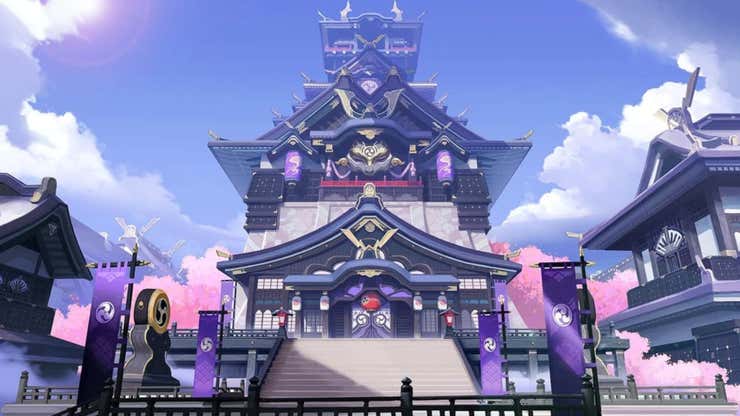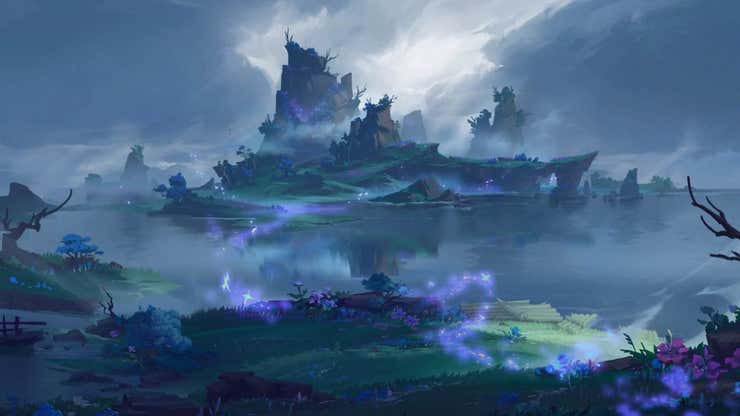Genshin Impact’s Heartbreaking Inazuma Side Quests Are Far Better Than Its Main Plot

As someone who had been enjoying Genshin Impact’s main story since launch, I wanted to like the core storyline of the game’s Inazuma region so badly. But while it grapples with interesting political and philosophical themes, unfortunately it doesn’t quite land in the execution. Since I didn’t have any attachment to the city-state, I put off completing its side quests for as long as possible. This was a mistake. Inazuma’s side quests and non-playable characters are some of the most emotionally compelling content in the latest updates. They’re so good that it feels a little wrong that you’re allowed to skip them. Or in my case, put them off for months on end.
Let’s get the painful fact out of the way: There were serious problems with the main plot. The resistance’s motivations felt hamfisted, Kokomi wasn’t a serious challenger to the tyrannical Raiden Shogun’s regime, and the ending never resolved the problems that caused the war in the first place. I didn’t feel a strong emotional connection to Inazuma, and I wasn’t sure if any of its people did either. The vast majority of characters I met from the region were leaving (or trying to leave) for a better life, having completely given up on their homeland. By the time that I wrapped Raiden Shogun’s character quest, I was convinced that Inazuma was a deadly, hopeless place.
After clearing several sidequests, I realized that I was wrong. Inazuma is no less gut-punching than the previous regions of Mondstadt or Liyue. You just have to actively seek out the world quests. Or you could read this article about which ones made my heart hurt the most.
Through the Mists

This series of quests on Tsurumi island should have been part of the main plot, and I’m disheartened that it isn’t. In it, players investigate a foggy island that seems to be locked in a time loop. At the center of it all is a young ghost boy who seems determined to undergo a ritual where he sacrifices his life to the island’s Thunderbird. At least, that’s how matters appear from the outside. Believing that sacrificing his life would enable his friends to return to the island, Ruu sacrifices himself to his fellow villagers.This only angers the Thunderbird, a god whom he befriended, who then destroys the village for killing him. It’s a tragic misunderstanding that has endured for a thousand years, and only your arrival manages to help break the cycle.
Unlike the main plot, every quest in the chain is a carefully constructed emotional beat that manages to wrap neatly at the end. At first, it takes you a couple of loops to understand why you can’t get a quest item off the island. When you find out about what the villagers had done to Ruu, you try to stop the time loop by destroying the ceremonial altars. This in turn upsets the boy, who feels that you’ve betrayed his friendship. To regain Ruu’s trust, you have to allow one of his friends’ descendants to talk to him. Only then is he able to come to terms with the fact that his sacrifice was unnecessary. Afterwards, you have to figure out a way to take him to Seirai Island, where the Thunderbird was killed by Inazuma’s god.
The execution of the ending is sublime. One of the final cutscenes is simple, but it’s one of my favorite moments in the game. How many times have I gone to Seirai Island to complete daily quests? I had seen that island as a hostile place where I was constantly watching for bandits. But only during “Through the Mists” did I come to appreciate its beauty through the saturated glow of the early dawn. It was far more effective than anything that the main resistance story had done, despite the latter appearing to have a larger animation budget.
“Through the Mists” shows that Genshin Impact is at its best when it tries to execute small, contained stories that don’t have to please its immensely large player base. Inazuma didn’t need to be over-the-top about its dramatics. It just needed to have heart.
Sacred Sakura Cleansing Ritual

This fascinating plotline explains the history of Inazuma before the current god took her sister’s place. It’s not a perfect questline. Some quests feel disjointed, and I wish that some of the lore was delivered earlier so that I could better contextualize the events. The main reason why this quest is here is because of one specific moment. During this story, I was looking for a particular quest item that was being held by a tanuki spirit. I didn’t like him very much. He had a difficult personality that made it difficult for me to take him seriously.
But at the end of his quest, I found out that he was still waiting for his best friend to find him in their 500-year-old game of hide-and-seek. He had no idea that his friend had initiated the game to protect his life, and that she had already died all those years ago. While I think it’s a little fucked up that I didn’t get the opportunity to tell him what happened to his friend, I appreciate that this quest stuck with me long after I completed it. Previously, I had largely found Inazuma to be an austere, humorless place. But these personal stories made it easier to relate to a country steeped in so many philosophical and political extremes.
And the kicker at the end of the quest? Ouch. You’ll have to complete a boss fight where you’re solving complex puzzles on-the-fly while trying to avoid electrocution, but the ending is worth your time.
The Solitary Sea-Beast

In most Genshin quests, you uncover information about the past by speaking to NPCs. “The Solitary Sea-Beast” on Watasumi Island is no exception. At the beginning, a young woman tells you about a sea creature that was the last of its kind, a reference to a real-life whale that vocalized at a different frequency than others of its species. “The Solitary Sea-Beast” tells the story of two young women who struggle to find belonging on Watasumi Island for their own personal reasons. The quest is a beautiful exploration of social ostracization and whether anyone is “meant” to be alone.
This quest hits even harder because the characters it centers on are clearly queer. They flirt with one another, the protagonist lampshades their attraction to one another, and one woman invites the other to stay at her house for the long term. “Are some people inherently meant to be lonely?” is a question that I’ve asked myself many times while existing in a cishet world where I will forever be a small minority. “The Solitary Sea-Beast” wrapped neatly, effectively using the setting’s lore to resolve a fundamental conflict in a rather complicated NPC.
I preferred being able to help a few minor characters achieve a small bit of happiness over what happened in the main plot. As I mentioned in a previous article, I don’t feel that the main plot resolved the underlying problems in how a distant god tried to rule indirectly through a puppet. While the major factions are at peace, it feels almost inevitable that they will one day clash again. But saving a woman’s crush and helping them unite feels substantial and meaningful. When I returned to check on them a little while later, one woman gave me a badly cooked dish that the other had made. Despite their plain appearances and their lack of importance in the main plot, their story defined my impressions of Watasumi Island as much as the resistance army did.
The quest also helped to reframe how I thought about the difficult puzzles on the islands. Most of the time, I feel really bad about looting islands of their hidden treasures. Unlike environmental puzzles in some games which are presented as you heroically “beating” the designers of a tomb’s devious traps to rob the dead, solving puzzles on Watasumi is a process of engaging with the local culture on its own terms. A researcher explains that the puzzles on Watasumi Island are part of a long-established ritual of communicating with the deceased. That was a neat way to make me feel more emotionally involved in solving puzzles on the island, without framing my character as a tomb robber.
Inazuma is a fascinating region with premises that were largely squandered by the main plot. But its side quests show that the writers are plenty capable of doing its stories justice. We already got a fascinating story out of the Labyrinth Warriors event, and I’m looking forward to how future content updates add better stories to Inazuma. The main plot sorely needs them.
Source: Kotaku
About the game
Genshin Impact
- Release date: September 28, 2020
- Developer(s): HoYoverse
- Publisher(s): HoYoverse
- Game mode(s): Single player, Co-operative, Multiplayer
- Platform(s): PC (Microsoft Windows), iOS, PlayStation 4, Nintendo Switch, PlayStation 5, Android



Comments
Log in to your account or create one for free on MG Community to participate in comments.